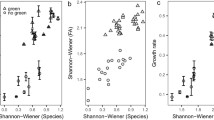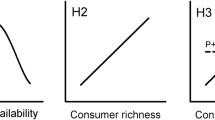Abstract
Consumer diversity effects on ecosystem functioning are highly context dependent and are determined by consumer specialization and other consumer and prey specific traits such as growth and grazing rates. Despite complex reciprocal interactions between consumers and their prey, few experimental studies have focused on prey diversity effects on consumer dynamics and trophic transfer. In microbial microcosms, we investigated effects of algal prey diversity (one, two and four species) on the production, evenness and grazing rates of 4 ciliate consumers, differing in grazing preferences and rates. Prey diversity increased prey biovolume in the absence of consumers and had opposing effects on different consumers, depending on their specialization and their preferred prey. Consumers profited from prey mixtures compared to monocultures of non-preferred prey, but responded negatively if preferred prey species were offered together with other species. Prey diversity increased consumer evenness by preventing dominance of specific consumers, demonstrating that the loss of prey species may have cascading effects resulting in reduced consumer diversity. Our study emphasizes that not only the degree of specialization but also the selectivity for certain prey species within the dietary niche may alter the consequences of changing prey diversity in a food web context.




Similar content being viewed by others
References
Bruno JF, Boyer KE, Duffy JE, Lee SC (2008) Relative and interactive effects of plant and grazer richness in a benthic marine community. Ecology 89:2518–2528. doi:10.1890/07-1345.1
Cardinale BJ et al (2006) Effects of biodiversity on the functioning of trophic groups and ecosystems. Nature 443:989–992. doi:10.1038/nature05202
Cardinale BJ et al (2011) The functional role of producer diversity in ecosystems. Am J Bot 98:572–592. doi:10.3732/ajb.1000364
Cardinale BJ et al (2012) Biodiversity loss and its impact on humanity. Nature 486:59–67. doi:10.1038/nature11148
DeMott WR, Gulati RD, Siewertsen K (1998) Effects of phosphorus-deficient diets on the carbon and phosphorus balance of Daphnia magna. Limnol Oceanogr 43:1147–1161. doi:10.4319/lo.1998.43.6.1147
Duffy JE, Richardson JP, Canuel EA (2003) Grazer diversity effects on ecosystem functioning in seagrass beds. Ecol Lett 6:637–645. doi:10.1046/j.1461-0248.2003.00474.x
Duffy JE, Cardinale BJ, France KE, McIntyre PB, Thébault E, Loreau M (2007) The functional role of biodiversity in ecosystems: incorporating trophic complexity. Ecol Lett 10:522–538
Dzialowski AR, Smith VH (2008) Nutrient dependent effects of consumer identity and diversity on freshwater ecosystem function. Freshw Biol 53:148–158
Edwards KF, Aquilino KM, Best RJ, Sellheim KL, Stachowicz JJ (2010) Prey diversity is associated with weaker consumer effects in a meta-analysis of benthic marine experiments. Ecol Lett 13:194–201. doi:10.1111/j.1461-0248.2009.01417.x
Engelhardt KAM, Ritchie ME (2001) Effects of macrophyte species richness on wetland ecosystem functioning and services. Nature 411:687–689
Filip J, Müller LL, Hillebrand H, Moorthi SD (2012) Nutritional mode and specialization alter protist consumer diversity effects on prey assemblages. Aquat Microb Ecol 66:257–269. doi:10.3354/ame01573
Filip J, Bauer B, Hillebrand H, Beniermann A, Gaedke U, Moorthi SD (2014) Multitrophic diversity effects depend on consumer specialization and species-specific growth and grazing rates. Oikos 123:912–922. doi:10.1111/oik.01219
Finke DL, Snyder WE (2008) Niche partitioning increases resource exploitation by diverse communities. Science 321:1488–1490. doi:10.1126/science.1160854
Gamfeldt L, Hillebrand H, Jonsson PR (2005) Species richness changes across two trophic levels simultaneously affect prey and consumer biomass. Ecol Lett 8:696–703
Griffin JN, Byrnes JEK, Cardinale BJ (2013) Effects of predator richness on prey suppression: a meta-analysis. Ecology 94:2180–2187. doi:10.1890/13-0179.1
Hamback PA, Jon A, Ericson L (2000) Associational resistance: insect damage to purple loosestrife reduced in thickets of sweet gale. Ecology 81:1784–1794. doi:10.2307/177270
Hillebrand H, Cardinale BJ (2004) Consumer effects decline with prey diversity. Ecol Lett 7:192–201. doi:10.1111/j.1461-0248.2004.00570.x
Hillebrand H, Matthiessen B (2009) Biodiversity in a complex world: consolidation and progress in functional biodiversity research. Ecol Lett 12:1405–1419. doi:10.1111/j.1461-0248.2009.01388.x
Hillebrand H, Dürselen C-D, Kirschtel D, Pollingher U, Zohary T (1999) Biovolume calculation for pelagic and benthic microalgae. J Phycol 35:403–424
Hillebrand H, Bennett DM, Cadotte MW (2008) Consequences of dominance: a review of evenness effects on local and regional ecosystem processes. Ecology 89:1510–1520. doi:10.1890/07-1053.1
Hooper DU et al (2005) Effects of biodiversity on ecosystem functioning: a consensus of current knowledge. Ecol Monogr 75:3–35. doi:10.1890/04-0922
Katano I, Doi H, Eriksson BK, Hillebrand H (2015) A cross-system meta-analysis reveals coupled predation effects on prey biomass and diversity. Oikos 124:1427–1435. doi:10.1111/oik.02430
Kratina P, Vos M, Anholt BR (2007) Species diversity modulates predation. Ecology 88:1917–1923
Loreau M, Hector A (2001) Partitioning selection and complementarity in biodiversity experiments. Nature 412:72–76
McFadden GI, Melkonian M (1986) Use of Hepes buffer for microalgal culture media and fixation for electron microscopy. Phycologia 25:551–557. doi:10.2216/i0031-8884-25-4-551.1
Moorthi S, Hillebrand H, Wahl M, Berninger U-G (2008) Consumer diversity enhances secondary production by complementarity effects in experimental ciliate assemblages. Estuaries Coasts 31:152–162. doi:10.1007/s12237-007-9015-6
Naeem S, Hahn DR, Schuurman G (2000) Producer-decomposer co-dependency influences biodiversity effects. Nature 403:762–764
Narwani A, Mazumder A (2010) Community composition and consumer identity determine the effect of resource species diversity on rates of consumption. Ecology 91:3441–3447. doi:10.1890/10-0850.1
Petchey OL et al (2004) Species loss and the structure and functioning of multitrophic aquatic systems. Oikos 104:467–478
R Core Team (2012) R: a language and environment for statistical computing. R foundation for statistical computing, Vienna. http://www.R-project.org/
Saleem M, Fetzer I, Harms H, Chatzinotas A (2013) Diversity of protists and bacteria determines predation performance and stability. ISME J 7:1912–1921. doi:10.1038/ismej.2013.95
Srivastava DS et al (2009) Diversity has stronger top-down than bottom-up effects on decomposition. Ecology 90:1073–1083
Stachowicz JJ, Bruno JF, Duffy EJ (2007) Understanding the effects of marine biodiversity on communities and ecosystems. Annu Rev Ecol Evol Syst 38:739–766
Steiner CF (2001) The effects of prey heterogeneity and consumer identity on the limitation of trophic-level biomass. Ecology 82:2495–2506
Steiner CF, Darcy-Hall TL, Dorn NJ, Garcia EA, Mittelbach GG, Wojdak JM (2005) The influence of consumer diversity and indirect facilitation on trophic level biomass and stability. Oikos 110:556–566
Stoecker DK, Gifford DJ (1994) Preservation of marine planktonic ciliates: losses and cell shrinkage during fixation. Mar Ecol Prog Ser 110:293–299
Straub CS, Snyder WE (2006) Species identity dominates the relationship between predator biodiversity and herbivore suppression. Ecology 87:277–282
Thébault E, Loreau M (2003) Food-web constraints on biodiversity–ecosystem functioning relationships. Proc Natl Acad Sci USA 100:14949–14954
Wahl M, Hay M (1995) Associational resistance and shared doom: effects of epibiosis on herbivory. Oecologia 102:329–340. doi:10.1007/BF00329800
Wohlgemuth D, Solan M, Godbold JA (2016) Specific arrangements of species dominance can be more influential than evenness in maintaining ecosystem process and function. Sci Rep 6:39325
Worsfold NT, Warren PH, Petchey OL (2009) Context-dependent effects of predator removal from experimental microcosm communities. Oikos 118:1319–1326
Zedler JB, Callaway JC, Sullivan G (2001) Declining biodiversity: why species matter and how their functions might be restored in Californian tidal marshes. Bioscience 51:1005–1017
Acknowledgements
This work was funded by the German Research Foundation (DFG, MO 1931/1-1, MO 1931/3-1).
Author information
Authors and Affiliations
Contributions
Author contribution statement
HH and SDM conceived and designed the experiment. DW and JF conducted the experiment. HH, DW and SDM analyzed the data. DW and SDM wrote the manuscript, other authors provided content-related and editorial advice.
Corresponding author
Additional information
Communicated by Joel Trexler.
Electronic supplementary material
Below is the link to the electronic supplementary material.
Rights and permissions
About this article
Cite this article
Wohlgemuth, D., Filip, J., Hillebrand, H. et al. Prey diversity effects on ecosystem functioning depend on consumer identity and prey composition. Oecologia 184, 653–661 (2017). https://doi.org/10.1007/s00442-017-3892-6
Received:
Accepted:
Published:
Issue Date:
DOI: https://doi.org/10.1007/s00442-017-3892-6




